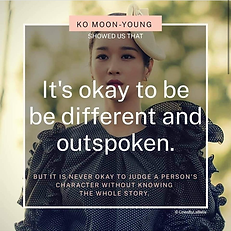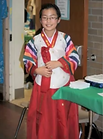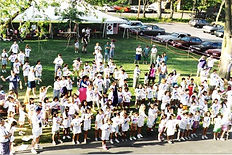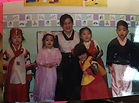The State of Things
Gracie Iwersen
I am Korean American. I was born in Busan, South Korea and was officially adopted by a white family in 2003. Growing up, I have experienced both direct and indirect discrimination based on my ethnicity. There have been several times in my life where I was treated differently because I am Asian. As James Baldwin spoke during his infamous “Pin Drop Speech” at Cambridge University in 1965, some grow up and think they’re white till they look in a mirror and realize they’re black (I Am Not Your Negro 17:23). I didn’t think I looked too different from my family, I thought I looked exactly like my older brothers and that I shared many of my parents’ features. It wasn’t until I was in elementary school when I finally realized why everyone would look at us differently in public; I am Asian and they’re white.
I am fortunate enough to have grown up in a diverse town where adoption is common – there’s even groups at the community center surrounding adoption and cultural immersion – but that did not stop my teachers from scratching their heads when I would explain who my siblings were. “You look nothing like them,” they would exclaim. “Are you sure?” was a question I got often, becoming flustered in front of my classmates on the first day of school every year. I envied my peers when my teachers would suddenly get excited and immediately make connections between them and their siblings. Despite my German last name, I have never had a teacher make that connection I so longed for.
My senior year of high school we read a lengthy article about the Othering and Belonging Institute at UC Berkeley. To most, it was another boring assignment, but to me it meant everything. I realized how the concept of “otherness,” as discussed by H. Alexander Chen, Jessica Trinh, and George P. Yang in an article about anti-Asian sentiment can be applied to my life. I have desperately tried to ‘belong’ to society throughout my life. When I was little, I sat while my peers pulled back the corners of their eyes out of fascination to have eyes that looked like mine. For the two years in elementary school when I took Korean classes at Trinity College, I was laughed at by my classmates while the teacher filled in most of the answers for me in my workbook, as I was completely new to the language while everyone else had been practicing Korean in their homes since birth. The only time I felt like I truly belonged was for the three days every summer when my parents and I would drive up to Albany, NY to attend Camp Mujigae, a summer camp for adopted Koreans. Three days out of 365 is pretty great.
Accompanying the “coming of age” period of my life, I have learned to live the life I wish to. Despite me being the outlier in a group of white friends and not being “Asian-enough” to be in the Asians, an exclusive friend group at my high school, I continue to embrace my culture and ethnicity. I have the South Korean flag hanging in my dorm, my Spotify includes mostly Korean artists, a necklace hanging around my neck says ‘유진,’ my birth name, my favorite food is tteokbokki, and I even have an air pod case that looks like a package of shin ramyun.
Similar to how history covers up the ethnic cleansing behind the concept of Manifest Destiny, my seventh grade world history class briefly discussed Asian immigration, only skimming the surface of the complicated past of cheap labor, exclusion acts, colonization, and anti-Asian sentiment. Echoing the words of James Baldwin in I Am Not Your Negro, Saum Song Bo wrote that “[t]his country is the land of liberty for all men of all nations except the Chinese” (Lew-Williams).
The term ‘yellow peril,’ used to describe the threat white people felt from East Asians (Odijie), is something that is not discussed in history classes. White people in Europe and the United States felt the rapid military and technology advances by Japan would result in global domination, adding to the already raging fire of reasons to discriminate Asians.
The California Gold Rush initiated the massive flow of Chinese immigration in the middle of the 19th century. Envious of the prosperity of the Chinese and the existing racism in the United States, President Chester A. Arthur signed the Chinese Exclusion Act in 1882, which would deny the immigration and naturalization of the Chinese (Chen, et al). Although the Act was repealed, the 1924 Immigration Act signed by President Calvin Coolidge placed limits on the number of Asian immigrants entering the United States, furthering efforts to suppress Asian representation. World War II did nothing to assist the rising problem of anti-Asian sentiment. The 1941 bombing of Pearl Harbor and Japan’s rising power led President Franklin D. Roosevelt to sign Executive Order 9066 a year later, ordering those “under suspicion as enemies” to be sent to internment camps in the middle of nowhere (De Leon). Despite acts of patriotism and being second and even third-generation Americans, nothing stopped thousands of Japanese Americans from being interned.
The COVID-19 pandemic has done nothing but cause a significant rise in anti-Asian racism. As we have seen in history with smallpox, the bubonic plague, and typhoid among a long list of infectious disease outbreaks, people are quick to find scapegoats and point fingers. As a result of the first reported cases of COVID-19 originating in Wuhan, China, Asians have become the scapegoat for the pandemic. While President Trump has referred to COVID-19 as the “Chinese Virus” multiple times, singling out the Chinese, the United States has seen a rise in anti-Asian hate crimes. The 1982 murder of Vincent Chin is one example of how Asians are often “seen as a single entity when it [comes] to discrimination,” (Chen, et al). A modern example is the stabbing of an Asian-American family at the beginning of the year because “[t]he suspect indicated that he stabbed the family because he thought the family was Chinese, and infecting people with the coronavirus,” according to the FBI (Wallace).
Throughout history, Asians have been added to the list of groups of people discriminated against in the United States. Whether it is the ideals behind colonization and Darwinism (Odijie), or the panic during a war or pandemic, racism and discrimination have always been an issue for Asians, despite what history classes may teach you. My experiences with indirect discrimination come from our history; the Exclusion Act, Immigration Act, Executive Order 9066, as well as the tendency to blame Asians for the 2003 SARS outbreak and 2020 COVID-19 pandemic have contributed to the anti-Asian sentiments spread across the country.
In an ideal world, in a decade or two, the world is free of racism, discrimination, disease, and everyone lives fairly and happily. In an ideal world, my children would grow up in a world free of hateful comments made about the shape of their eyes, the foods they eat, and the languages they speak. An ideal world like that doesn’t exist and may never exist. It will be my responsibility to teach my children about their cultures, telling them that the shape of their eyes is beautiful, the food they eat doesn’t look weird or smell bad, and how just because they may look different from others doesn’t mean they are below them. I will teach them to embrace their differences and stand up for what is right, not what may be considered as normal. It is impossible to force everyone into educating themselves about different cultures and the flaws in our history, but it is possible for us to stand up for ourselves, use our resources such as social media to provide educational material to others. Actions such as sharing articles highlighting discrimination, normalizing the art, food, and music of different countries, and refusing to tolerate the white-washed society we live in will help us take one step closer to our ideal world.
Works Cited
Chen, H Alexander et al. “Anti-Asian sentiment in the United States - COVID-19 and history.” American journal of surgery vol. 220,3 (2020): 556-557. doi:10.1016/j.amjsurg.2020.05.020
Chen, Li. “A Mixed-Race Child’s Fate Under the Chinese Exclusion Act: Lawrence Kentwell’s Fight for Inclusion in Local Politics and Legal Profession.” Asian Pacific American Law Journal, vol. 23, no. 1, Spring 2019, pp. 1–17. EBSCOhost, https://web.b.ebscohost.com/ehost/detail/detail?vid=7&sid=79854053-2ae4-4263-9cb6-7b7fad6cd6fe%40sessionmgr101&bdata=JnNpdGU9ZWhvc3QtbGl2ZQ%3d%3d#AN=137071749&db=aph.
Leon, Adrian De. The Long History of Racism against Asian Americans in the U.S. 9 Apr. 2020, www.pbs.org/newshour/nation/the-long-history-of-racism-against-asian-americans-in-the-u-s.
Lew-Williams, Beth. “Ric Burns and Li Shin Yu, Directors. The Chinese Exclusion Act.” American Historical Review, vol. 124, no. 1, Feb. 2019, pp. 178–180. EBSCOhost, doi:10.1093/ahr/rhy477.
Odijie, Michael. “The Fear of ‘Yellow Peril’ and the Emergence of European Federalist Movement.” Taylor & Francis Online, 19 May 2017, www.tandfonline.com/doi/full/10.1080/07075332.2017.1329751?scroll=top&needAccess=true.
Peck, Raoul, director. I Am Not Your Negro. Magnolia Pictures and Amazon Studios, 2016.
Wallace, Danielle. “Texas Man Accused of Stabbing Asian Family over Coronavirus Could Face FBI Hate Crime Charge.” Fox News, FOX News Network, 2 Apr. 2020, www.foxnews.com/us/texas-man-stabbing-asian-family-coronavirus-fbi-hate-crime.










Camp Mujigae 2011
Lee Junghye 2018




